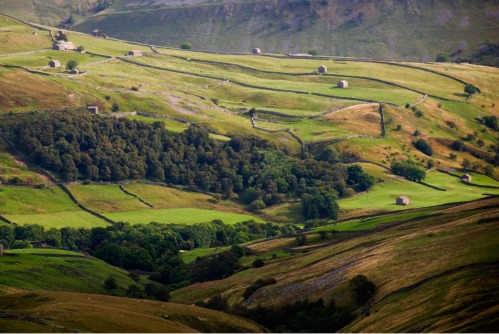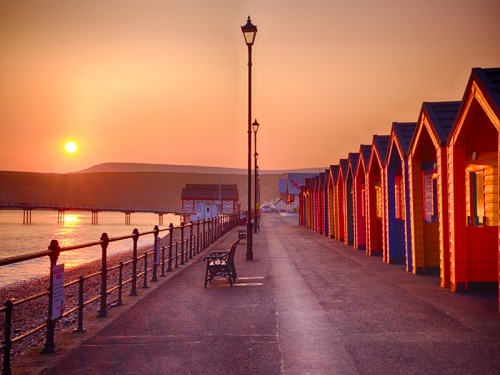Why You Should Visit Nidderdale

Designated an Area of Outstanding Natural Beauty back in 1994, although it sits outside the Yorkshire Dales National Park
moorland scenery and lush green meadowland. It may seem familiar to many as it featured heavily in the TV series of All Creatures Great and Small. The crossroads that played such a crucial part in the Christmas episode are just above Pateley Bridge, Nidderdale’s only town.

Niddderdale is the upper valley of the River Nidd, which flows south underground before surfacing down the dale where it forms several reservoirs including Scar House and Angram Reservoirs, before turning east and joining the Ouse. Both reservoirs are worth visiting for their peace and solitude and great walking opportunities. But the most famous attraction in
Nidderdale AONB is Brimham Rocks. These curious rock formations which have made weird and wonderful shapes are scattered over Brimham Moor. Sculpted by 320 million years of movement and hundreds of thousands of years of ice, wind and rain, these natural spectacles now resemble familiar creatures, and the rocks have taken on names such as the Dancing Bear, the Gorilla, the Eagle, the Smartie Tube and the Turtle. Some of these iconic rocks can be seen from a distance, but it takes roughly four hours to explore the whole of this fascinating site. Both the rocks and the surrounding moorland are Sites of Specific Scientific Interest and are home to rare species of heather and more than 70 bird boxes to attract blue and great tits, pied flycatchers and redstarts amongst others.
Amongst the earliest evidence of settlement in Nidderdale are a number of cup and ring marked rocks thought to date back to the early Bronze Age, and there is evidence of ancient mining activities here during the Roman period. By the 6th century, large-scale woodland clearances had made way for farmland around Pateley Bridge. Sadly, during the mid-11th century much of the area was laid waste by William the Conqueror and it appears that the population of Nidderdale was largely wiped out.
Wealthy medieval monasteries gradually acquired the land and created prosperous monastic agricultural estates that flourished for 300 years. The land was cleared and the area repopulated, and iron mining and small-scale quarrying expanded. But it was lead mining in the 19th century which saw the area become increasingly industrialised. Smelt mills were built and spoil heaps, still visible today, stretched through the valley. Lime kilns were also built to provide lime which was used as fertiliser (remains can be seen at Toft Gate), coal mines appeared at the northern end of Nidderdale, and the textile industry also flourished with water mills powering spinning frames for flax.
The 19th century also saw the enclosure of common pasture land and the appearance of the dry stone walls which characterise the area today. The smaller, irregular enclosures in the valley bottom pre-date the larger, rectangular field patterns on the valley sides. Whilst the walls privatised moorland that was previously accessible to all, they did bring wealthy landowners keen to develop lucrative grouse shoots, and build picturesque landscapes, parks and gardens, providing alternative employment in the dales.

The picturesque market town of Pateley Bridge has a great mix of independent shops, cafés and culture. The world’s oldest sweet shop is here, now under new ownership, but definitely worth a visit. The Nidderdale Museum is the place to go to learn more about beautiful Nidderdale. With 11 separate rooms devoted to different aspects of life in the dale, current exhibits include a Victorian parlour, a General Store and school room.
There are a number of great walking trails through Nidderdale AONB, and one starts in Pateley Bridge. The circular route (it’s 53 miles in total) takes you through the spectacular uplands around Scar House Reservoir, through fields and meadow-rich river valleys, and although it does include some challenging climbs, the views at the top are reward enough.
It passes Brimham Rocks, How Stean Gorge and Yorke’s Folly, a Grade II-listed folly which dominates the skyline above the village of Bewerley. Commissioned by the Yorke family, and built mainly to provide employment in a recession, the three original 18th century shafts were designed to look like the ruin of an arch, but sadly only two now remain. Arguably, however, the best views of Nidderdale are from Middlesmoor, a small hill village at the head of Nidderdale. An unspoilt spot, with cobbled streets and narrow gunnels, follow the cobbled lane to the churchyard where you can see for miles down the valley.
At the southern end of the dale, the Washburn Valley is a peaceful place to explore. With no major towns or villages, its main features are four reservoirs running the length of the valley from the moorland around Thruscross, which feeds down to Fewston and Swinsty Reservoirs and finally to the rolling open landscape around Lindley Wood Reservoir, where there are plenty of opportunities for walking cycling, fishing or just enjoying the wildlife.
Don't Miss
Once part of an extensive network of pleasure gardens for the Yorke family of Bewerley Hall, Fishpond Wood, together with Strikes Wood and Ravensgill, reflect what was called the ‘picturesque movement’, made famous by nearby Fountains Abbey and Studley Royal. Deliberately designed to look naturally wild, the layout of the paths and the pond at Fishpond Wood made the most of the dramatic rocky millstone outcrops and woodland. In the eastern corner of the woodland, the hall’s ice house has a large domed brick chamber set deep underground. It fell into disrepair following the demolition of the hall, but following careful restoration it remains a rare example of an 18th century icehouse in the area.
To the west of Pateley Bridge on Greenhow Hill is Coldstones Cut. Created by artist Andrew Sabin, it’s Yorkshire’s latest and largest free attraction which visitors can walk through and explore. The massive construction overlooks Coldstones Quarry and offers spectacular views across Nidderdale.
For the very active How Stean Gorge is a must visit. This limestone ravine, carved out over thousands of years, is popular for gorge walking, caving, climbing and abseiling, and even heli-canyoning. It is also home to the only Via Ferrata in Yorkshire, an aerial network of metal beams, ladders and cables set into the rocks, criss-crossing the gorge and passing right underneath How Stean’s glass-floored cafe. Book a full Big Five multiactivity day which tackles five of the most popular activities in one day, or make use of the on-site campsite to make the most of all the activities here.
One third of of Nidderdale AONB is open moorland, with no light pollution and uninterrupted views of the night sky. There are four official Dark Sky Discovery Sites, including Toft Gate Lime Kilns and Scar House Reservoir, where all you need to stargaze is a pair of binoculars, warm clothes, and maybe a flask of something warming too!
Stay A While
The Sportsman’s Arms is close to Coldstones Cut and is a great base for exploring the area. The restaurant here makes the most of local produce so expect some delicious classic Yorkshire dishes to fuel your explorations. The 18th century, pet-friendly Wellington Inn in Darley has 12 ensuite rooms and serves great food in the acclaimed Dining Room, with its expansive views, and in the Gun Room. Cosy Woodside Cottage in Bewerley sleeps two, or alternatively High Houses in Wath, which sleeps 10, is great for a group getaway. On the Wath Road, High Green Farm is a friendly B&B, and there are self-catering options at How Stean Gorge, but why not stay under canvas – the campsite here has the most amazing views.









